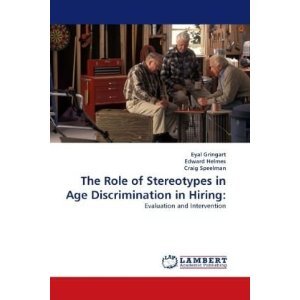The Role of Stereotypes in Age Discrimination in Hiring: Evaluation and Intervention
Gringart, Eyal, Helmes, Edward, and Speelman, Craig (2010) The Role of Stereotypes in Age Discrimination in Hiring: Evaluation and Intervention. Lambert Academic Publishing, Saarbrücken, Germany.
This is the latest version of this item.
![[img]](https://researchonline.jcu.edu.au/12160/2.hassmallThumbnailVersion/12160_Gringart_et_al_2010_Cover.jpg)
|
Image (JPEG) (Book Cover)
- Cover Image
Download (14kB) |
|
|
PDF (Front pages)
- Supplemental Material
Download (1MB) |
||
|
PDF (Back pages)
- Supplemental Material
Download (220kB) |
Abstract
As the number of older adults grows, governments find it increasingly harder to support them through social and health care services. One solution to this problem is for older adults to remain in paid employment longer. However, older workers are discriminated against due to negative stereotyping by employers. Previous research has found that older females experienced greater discrimination than did older males. In order to address the issue of hiring discrimination against older adults a progressive two-stage research project was conducted. Using a questionnaire that was developed especially for this project, Study One explored the stereotypes held about older workers of both genders among Australian employers and undergraduates, using a national random sample of 128 companies across industries and 187 undergraduates across disciplines. Study One used a 2 x 2 factorial design with sample (employers and undergraduates) and questionnaire version (asking about older males or females)as the independent variables. There were three continuous dependent variables (DVs): 'sum of scale' - a sum of the ratings of the questionnaire's stereotype scale, 'likely to hire' - ratings of respondents' likelihood to hire older workers, and 'age relevance' - ratings of how important respondents' viewed age in making hiring decisions. The results showed systematic stereotyping among both samples with no significant differences across questionnaire version. Both samples indicated that they were less than likely to hire older workers and viewed age as relevant in hiring. Study Two was designed to test two interventions that were aimed to promote positive attitude changes toward older workers. It comprised two stages and used a randomized-controlled trial. In the first stage, respondents were sent one of three intervention materials. One involved inducing cognitive dissonance. Another involved a fact sheet that presented the misconceptions about older workers that were identified in Study One and contrasted them with empirical data. The third was a combination of the other two. In the second, testing stage, those who responded to the intervention plus a new control group were all sent questionnaires to assess the effects of the interventions. Intervention materials were posted to a national random sample of 900 companies across industries and to 147 undergraduate research volunteers. At the testing stage 556 employers and 137 undergraduates were addressed. Ninety· seven undergraduates and 267 employers responded. The first stage of Study Two used a 2 x 2 x 2 between subjects design with cognitive dissonance (yes or no), fact sheet (yes or no), and sample (employers and undergraduates) as the independent variables. There were four dependent variables: 'age preference'- respondents' general age preference in hiring, 'sum of scale', 'age relevant', and 'likely to hire'. The last three DVs were based on those used in Study One. The results of Study Two showed no significant differences between either the fact sheet or the cognitive dissonance conditions and controls. The cognitive dissonance and fact sheet combination showed significant positive effects among employers but not among undergraduates. Employers in the combination condition had significantly higher mean 'sum of scale' and 'age preference' scores, and indicated that they were more than likely to hire older workers whilst all other conditions were less than likely to do so. These significant effects in the employers' sample make a case for using the cognitive dissonance and fact sheet combination method in combating hiring discrimination against older workers. The results suggest that the drive to reduce cognitive dissonance could be harnessed to change stereotypes. Finally, the results emphasize the potential of psychological interventions to bring about social changes and to enhance compliance with legislation.
| Item ID: | 12160 |
|---|---|
| Item Type: | Book (Scholarly Work) |
| ISBN: | 978-3-8383-3370-0 |
| Keywords: | ageing, hiring, stereotypes, employment, discrimination |
| Related URLs: | |
| Date Deposited: | 03 May 2011 02:32 |
| FoR Codes: | 17 PSYCHOLOGY AND COGNITIVE SCIENCES > 1701 Psychology > 170102 Developmental Psychology and Ageing @ 50% 17 PSYCHOLOGY AND COGNITIVE SCIENCES > 1701 Psychology > 170109 Personality, Abilities and Assessment @ 50% |
| SEO Codes: | 92 HEALTH > 9205 Specific Population Health (excl. Indigenous Health) > 920502 Health Related to Ageing @ 100% |
| Downloads: |
Total: 26915 Last 12 Months: 24 |
| More Statistics |
Available Versions of this Item
- The Role of Stereotypes in Age Discrimination in Hiring: Evaluation and Intervention. (deposited 03 May 2011 02:32) [Currently Displayed]



